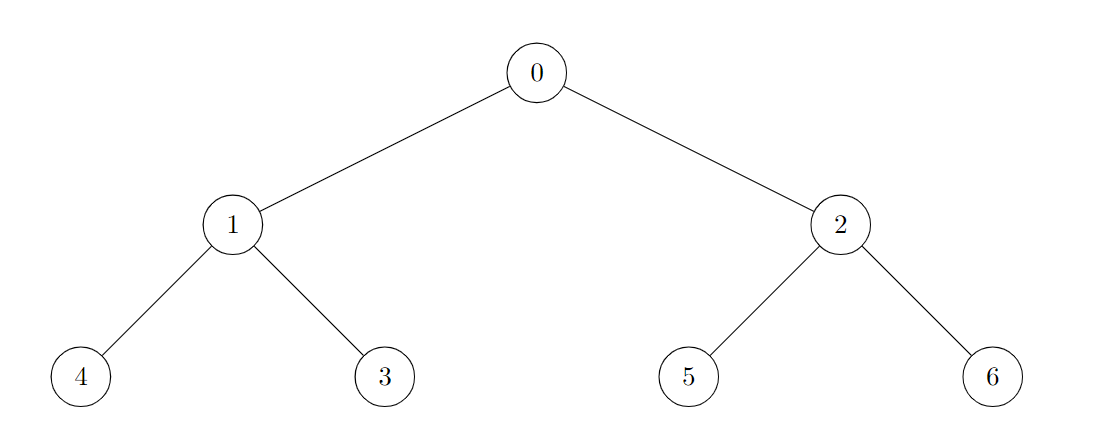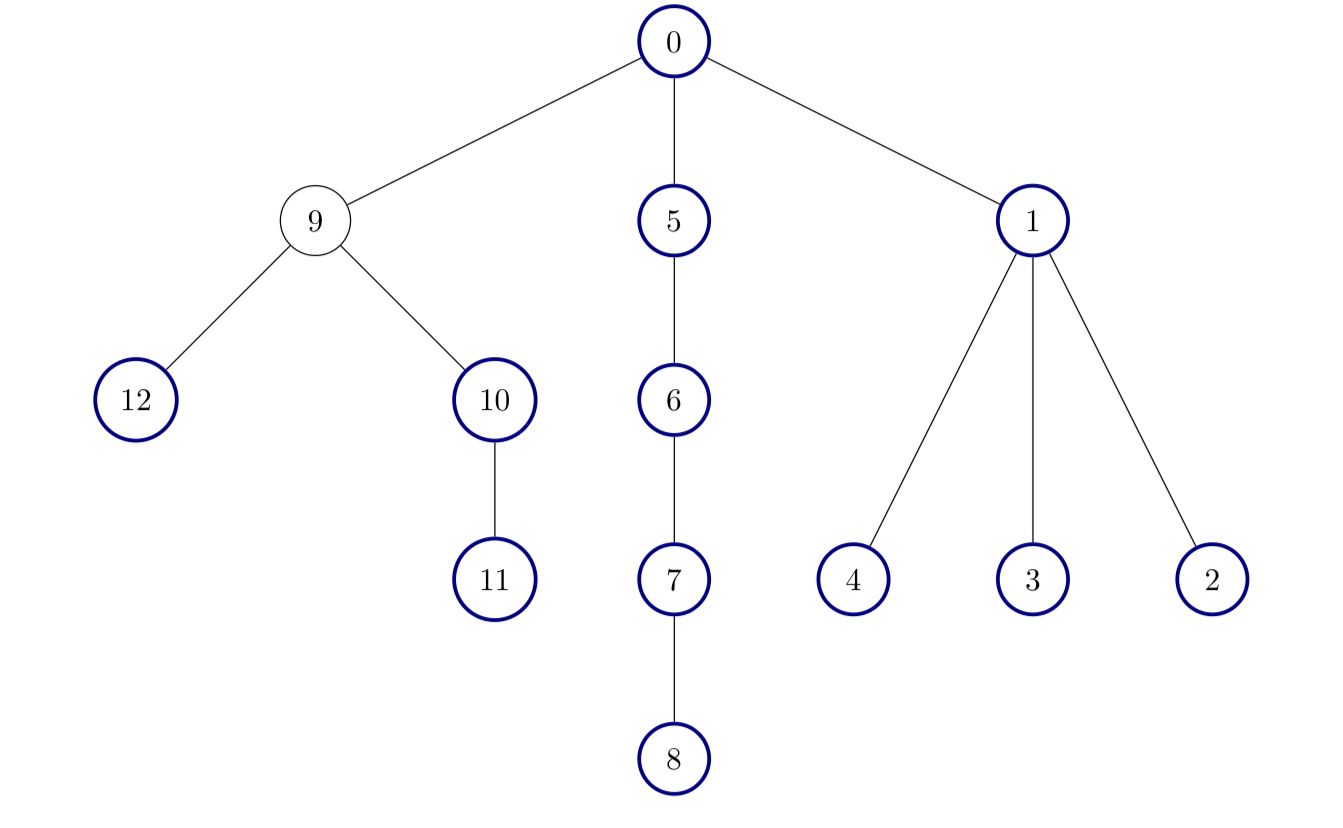3249. Count the Number of Good Nodes
Description
There is an undirected tree with n nodes labeled from 0 to n - 1, and rooted at node 0. You are given a 2D integer array edges of length n - 1, where edges[i] = [ai, bi] indicates that there is an edge between nodes ai and bi in the tree.
A node is good if all the subtrees rooted at its children have the same size.
Return the number of good nodes in the given tree.
A subtree of treeName is a tree consisting of a node in treeName and all of its descendants.
Example 1:
Input: edges = [[0,1],[0,2],[1,3],[1,4],[2,5],[2,6]]
Output: 7
Explanation:

All of the nodes of the given tree are good.
Example 2:
Input: edges = [[0,1],[1,2],[2,3],[3,4],[0,5],[1,6],[2,7],[3,8]]
Output: 6
Explanation:

There are 6 good nodes in the given tree. They are colored in the image above.
Example 3:
Input: edges = [[0,1],[1,2],[1,3],[1,4],[0,5],[5,6],[6,7],[7,8],[0,9],[9,10],[9,12],[10,11]]
Output: 12
Explanation:

All nodes except node 9 are good.
Constraints:
2 <= n <= 105edges.length == n - 1edges[i].length == 20 <= ai, bi < n- The input is generated such that
edgesrepresents a valid tree.
Solutions
Solution 1: DFS
First, we construct the adjacency list $\textit{g}$ of the tree based on the given edges $\textit{edges}$, where $\textit{g}[a]$ represents all the neighboring nodes of node $a$.
Next, we design a function $\textit{dfs}(a, \textit{fa})$ to calculate the number of nodes in the subtree rooted at node $a$ and to accumulate the count of good nodes. Here, $\textit{fa}$ represents the parent node of node $a$.
The execution process of the function $\textit{dfs}(a, \textit{fa})$ is as follows:
Initialize variables $\textit{pre} = -1$, $\textit{cnt} = 1$, $\textit{ok} = 1$, representing the number of nodes in a subtree of node $a$, the total number of nodes in all subtrees of node $a$, and whether node $a$ is a good node, respectively.
Traverse all neighboring nodes $b$ of node $a$. If $b$ is not equal to $\textit{fa}$, recursively call $\textit{dfs}(b, a)$, with the return value being $\textit{cur}$, and add $\textit{cur}$ to $\textit{cnt}$. If $\textit{pre} < 0$, assign $\textit{cur}$ to $\textit{pre}$; otherwise, if $\textit{pre}$ is not equal to $\textit{cur}$, it means the number of nodes in different subtrees of node $a$ is different, and set $\textit{ok}$ to $0$.
Finally, add $\textit{ok}$ to the answer and return $\textit{cnt}$.
In the main function, we call $\textit{dfs}(0, -1)$ and return the final answer.
The time complexity is $O(n)$, and the space complexity is $O(n)$. Here, $n$ represents the number of nodes.
Python3
class Solution:
def countGoodNodes(self, edges: List[List[int]]) -> int:
def dfs(a: int, fa: int) -> int:
pre = -1
cnt = ok = 1
for b in g[a]:
if b != fa:
cur = dfs(b, a)
cnt += cur
if pre < 0:
pre = cur
elif pre != cur:
ok = 0
nonlocal ans
ans += ok
return cnt
g = defaultdict(list)
for a, b in edges:
g[a].append(b)
g[b].append(a)
ans = 0
dfs(0, -1)
return ans
Java
class Solution {
private int ans;
private List<Integer>[] g;
public int countGoodNodes(int[][] edges) {
int n = edges.length + 1;
g = new List[n];
Arrays.setAll(g, k -> new ArrayList<>());
for (var e : edges) {
int a = e[0], b = e[1];
g[a].add(b);
g[b].add(a);
}
dfs(0, -1);
return ans;
}
private int dfs(int a, int fa) {
int pre = -1, cnt = 1, ok = 1;
for (int b : g[a]) {
if (b != fa) {
int cur = dfs(b, a);
cnt += cur;
if (pre < 0) {
pre = cur;
} else if (pre != cur) {
ok = 0;
}
}
}
ans += ok;
return cnt;
}
}
C++
class Solution {
public:
int countGoodNodes(vector<vector<int>>& edges) {
int n = edges.size() + 1;
vector<int> g[n];
for (const auto& e : edges) {
int a = e[0], b = e[1];
g[a].push_back(b);
g[b].push_back(a);
}
int ans = 0;
auto dfs = [&](this auto&& dfs, int a, int fa) -> int {
int pre = -1, cnt = 1, ok = 1;
for (int b : g[a]) {
if (b != fa) {
int cur = dfs(b, a);
cnt += cur;
if (pre < 0) {
pre = cur;
} else if (pre != cur) {
ok = 0;
}
}
}
ans += ok;
return cnt;
};
dfs(0, -1);
return ans;
}
};
Go
func countGoodNodes(edges [][]int) (ans int) {
n := len(edges) + 1
g := make([][]int, n)
for _, e := range edges {
a, b := e[0], e[1]
g[a] = append(g[a], b)
g[b] = append(g[b], a)
}
var dfs func(int, int) int
dfs = func(a, fa int) int {
pre, cnt, ok := -1, 1, 1
for _, b := range g[a] {
if b != fa {
cur := dfs(b, a)
cnt += cur
if pre < 0 {
pre = cur
} else if pre != cur {
ok = 0
}
}
}
ans += ok
return cnt
}
dfs(0, -1)
return
}
TypeScript
function countGoodNodes(edges: number[][]): number {
const n = edges.length + 1;
const g: number[][] = Array.from({ length: n }, () => []);
for (const [a, b] of edges) {
g[a].push(b);
g[b].push(a);
}
let ans = 0;
const dfs = (a: number, fa: number): number => {
let [pre, cnt, ok] = [-1, 1, 1];
for (const b of g[a]) {
if (b !== fa) {
const cur = dfs(b, a);
cnt += cur;
if (pre < 0) {
pre = cur;
} else if (pre !== cur) {
ok = 0;
}
}
}
ans += ok;
return cnt;
};
dfs(0, -1);
return ans;
}